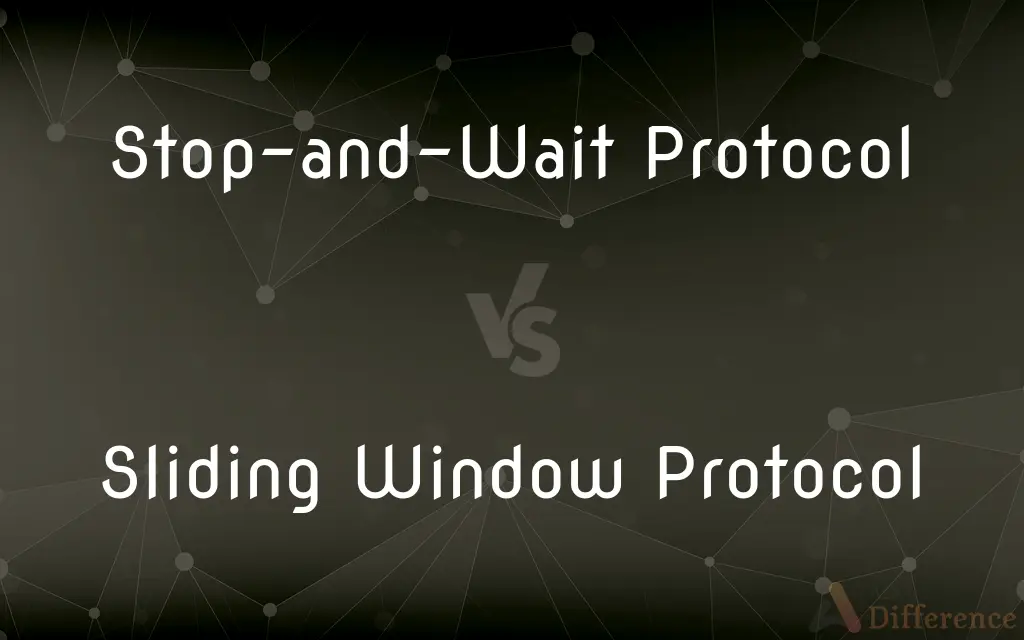Stop-and-Wait Protocol vs. Sliding Window Protocol — What's the Difference?
By Tayyaba Rehman — Published on January 10, 2024
Stop-and-Wait Protocol is a basic flow control method where the sender waits for an acknowledgment after each transmission, while Sliding Window Protocol is a more advanced technique allowing multiple frames to be sent before waiting for acknowledgments.

Difference Between Stop-and-Wait Protocol and Sliding Window Protocol
Table of Contents
ADVERTISEMENT
Key Differences
Efficiency and Throughput: Stop-and-Wait Protocol is less efficient, with lower throughput, as it sends one frame at a time and waits for its acknowledgment. Sliding Window Protocol increases efficiency and throughput by allowing multiple frames to be in transit simultaneously.
Window Size: In Stop-and-Wait, the window size is effectively one, meaning only one frame can be sent at a time. Sliding Window Protocol uses a larger window size, permitting multiple frames to be sent and acknowledged in batches.
Complexity and Implementation: Stop-and-Wait is simpler and easier to implement but less efficient for high-latency networks. Sliding Window Protocol is more complex but much more efficient in terms of network resource utilization.
Error Handling: Both protocols handle errors, but Stop-and-Wait can be slower in recovery due to its single-frame mechanism. Sliding Window Protocol can recover more quickly as it continues transmitting other frames while dealing with error recovery.
Suitability: Stop-and-Wait is suitable for simpler, low-speed, or less reliable networks. Sliding Window Protocol is better for high-speed, high-reliability networks.
ADVERTISEMENT
Comparison Chart
Efficiency
Less efficient, lower throughput
More efficient, higher throughput
Window Size
Window size of one
Larger window size, multiple frames
Complexity
Simpler, easier to implement
More complex but optimizes data flow
Error Recovery
Slower recovery from errors
Faster error recovery
Best Use Case
Low-speed or unreliable networks
High-speed, reliable networks
Compare with Definitions
Stop-and-Wait Protocol
Suitable for error detection and correction in each frame.
The protocol ensures error detection by acknowledging each frame individually.
Sliding Window Protocol
Utilizes a window to control the number of frames sent.
The protocol's window size determines how many frames can be in transit.
Stop-and-Wait Protocol
Involves higher waiting times and lower throughput.
Stop-and-Wait Protocol results in increased waiting times for data transmission.
Sliding Window Protocol
More complex but offers higher efficiency and throughput.
Despite its complexity, Sliding Window Protocol optimizes network performance.
Stop-and-Wait Protocol
Simple flow control method with a window size of one.
Due to its simplicity, Stop-and-Wait Protocol is easy to implement.
Sliding Window Protocol
Suitable for high-speed and reliable networks.
For our reliable fiber-optic network, Sliding Window Protocol is ideal.
Stop-and-Wait Protocol
Less efficient for networks with high latency.
In high-latency networks, Stop-and-Wait Protocol can significantly slow down data transfer.
Sliding Window Protocol
Allows sending multiple frames before receiving acknowledgments.
Sliding Window Protocol improves throughput in our high-speed network.
Stop-and-Wait Protocol
Transmits one frame at a time and waits for its acknowledgment.
Stop-and-Wait Protocol is used in our low-speed network for reliable transmission.
Sliding Window Protocol
Provides faster error recovery compared to Stop-and-Wait.
Error recovery is quicker in Sliding Window Protocol due to continuous frame transmission.
Common Curiosities
How does Sliding Window Protocol improve efficiency?
By allowing multiple frames to be sent and received without waiting for individual acknowledgments, it maximizes the use of network resources.
What is Stop-and-Wait Protocol?
It's a flow control protocol where the sender transmits one frame and waits for its acknowledgment before sending the next.
What is Sliding Window Protocol?
It's an advanced flow control protocol that allows multiple frames to be sent before receiving acknowledgments.
Can Stop-and-Wait Protocol handle high network latency well?
No, high latency can significantly decrease its efficiency.
Does Sliding Window Protocol require more processing power?
Yes, due to its complexity and management of multiple frames, it requires more processing resources.
How is the window size determined in Sliding Window Protocol?
The window size is usually determined based on the network's capacity and latency to optimize throughput.
Why is Stop-and-Wait Protocol less efficient?
It's less efficient due to idle waiting times after sending each frame.
Can the window size in Sliding Window Protocol change dynamically?
Yes, in adaptive versions of the protocol, the window size can change based on network conditions.
Is Sliding Window Protocol suitable for all types of networks?
It's best suited for reliable, high-speed networks due to its complexity and resource requirements.
How does Sliding Window Protocol handle lost frames?
It typically uses selective acknowledgment and retransmission strategies for lost frames.
What type of error handling is used in Stop-and-Wait Protocol?
It uses acknowledgment and timeout mechanisms for error detection and handling.
What are the main disadvantages of Sliding Window Protocol?
Its main disadvantages are increased complexity and resource requirements for managing multiple frames.
What happens when a frame is lost in Stop-and-Wait Protocol?
The sender will retransmit the frame after a timeout period.
Is Stop-and-Wait Protocol used in modern networks?
It's less common in modern high-speed networks but still used in specific scenarios where simplicity is key.
Which protocol is easier to implement and debug?
Stop-and-Wait Protocol is easier to implement and debug due to its simplicity.
Share Your Discovery

Previous Comparison
Altruism vs. Prosocial Behavior
Next Comparison
Contact Lenses vs. GlassesAuthor Spotlight
Written by
Tayyaba RehmanTayyaba Rehman is a distinguished writer, currently serving as a primary contributor to askdifference.com. As a researcher in semantics and etymology, Tayyaba's passion for the complexity of languages and their distinctions has found a perfect home on the platform. Tayyaba delves into the intricacies of language, distinguishing between commonly confused words and phrases, thereby providing clarity for readers worldwide.












































